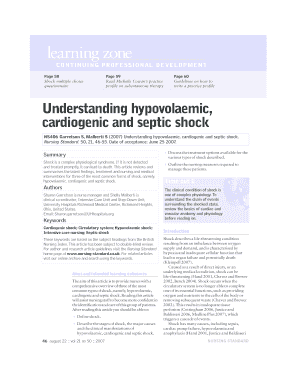
Get Understanding Hypovolaemic, Cardiogenic And Septic Shock.
How it works
-
Open form follow the instructions
-
Easily sign the form with your finger
-
Send filled & signed form or save
How to fill out the Understanding Hypovolaemic, Cardiogenic And Septic Shock. online
This guide aims to assist users in completing the Understanding Hypovolaemic, Cardiogenic And Septic Shock. document online. By following the steps outlined here, users will be well-equipped to effectively fill out each section of the form.
Follow the steps to successfully complete the form.
- Click the ‘Get Form’ button to access the Understanding Hypovolaemic, Cardiogenic And Septic Shock. document and open it for editing.
- Begin with the section on patient identification. Enter all required information, such as the patient's name, age, and contact details. Ensure accuracy to facilitate effective communication regarding the patient's condition.
- Next, move on to the medical history section. Provide comprehensive details about the patient’s medical background, including any existing conditions and previous episodes of shock. This information is critical for developing an informed treatment plan.
- Complete the section on observed symptoms. Describe any indicators of hypovolaemic, cardiogenic, or septic shock that the patient is exhibiting. Use clear language to convey the patient's condition accurately.
- Proceed to treatment options and recommendations. Outline suggested interventions based on the patient's current state. Include any urgent actions that need consideration.
- Lastly, save the document. You may download a copy for your records, print it out, or share it accordingly. Ensure that all necessary updates are included before finalizing.
Complete your documentation online to enhance patient care and improve response times in treatment.
Related links form
The four categories of shock include hypovolemic, cardiogenic, distributive, and obstructive shock. Understanding hypovolaemic, cardiogenic, and septic shock involves recognizing these categories, with hypovolemic shock stemming from fluid loss, and cardiogenic shock arising from poor heart function. Distributive shock involves abnormal blood vessel dilation, often seen in septic shock, while obstructive shock results from physical impediments to blood flow. Each category presents different causes and treatment methods.
Industry-leading security and compliance
-
In businnes since 199725+ years providing professional legal documents.
-
Accredited businessGuarantees that a business meets BBB accreditation standards in the US and Canada.
-
Secured by BraintreeValidated Level 1 PCI DSS compliant payment gateway that accepts most major credit and debit card brands from across the globe.


